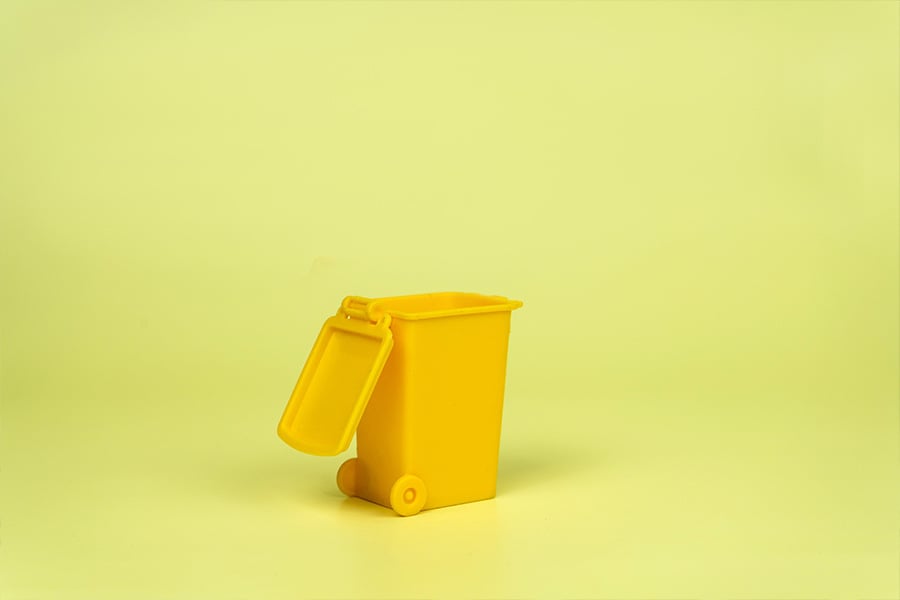Digital waste is a form of pollution that is often overlooked. One of the biggest contributors? Emails. Fortunately, it's is also one of the easiest forms of digital waste to reduce.
In this blog, you'll learn what digital waste is, get practical tips for reducing it-starting with your inbox-and read how we at Milgro got started with it.
What is digital waste?
Emails, documents, photos, old downloads-these are all forms of digital waste. Researchers estimate that we will produce more than 180 zettabytes* of data worldwide by 2026. That's equivalent to about 6.8 trillion hours of streaming on Netflix. By comparison, 2015 was only 12 zettabytes.
At least half of this large amount of data consists of dark data: unused and often forgotten files. Although this data is not used, it remains stored on servers.
These servers are housed in data centers that run day and night to store, process and secure files. Because data centers operate 24/7, servers require energy all the time. In addition, servers can get very hot, requiring cooling systems to keep them at the right temperature. The energy consumption of this cooling is often as high as that of the servers themselves.
Many data centers use electricity generated from fossil fuels such as coal and natural gas, causing carbon emissions.
Due to the high energy consumption of servers and cooling systems combined with the use of fossil energy, data centers account for 2.5% of total global carbon emissions - more than international aviation (2.1%).
*Computers store files in bytes. One byte consists of eight bits.
- 1 gigabyte (GB) = about 1 billion bytes (equivalent to about 200 songs)
- 1 terabyte (TB) = 1,000 gigabytes
- 1 petabyte (PB) = 1,000 terabytes (enough to store about 500 billion pages of text).
- 1 zettabyte (ZB) = 1 billion terabytes.
The impact of AI on energy consumption
The growth of artificial intelligence (AI) has greatly increased energy consumption in data centers. Between 2020 and 2023, this consumption doubled, partly due to the emergence of AI applications. To illustrate:
- Training an AI model can consume as much energy as 100 households a year.
- An AI chatbot consumes up to 10 times more energy than a regular Google search.
The impact of emails
Emails are part of digital waste. According to estimates , a single email results in an average of 4 grams of CO2 emissions. If you send 20 emails a day, one year is equivalent to the CO2 emissions of a gasoline car driving 800 kilometers*.
*This is based on average emissions of 4 grams of CO2 per e-mail and 149 grams of CO2 per kilometer for an average gasoline car.
Why is e-mail traffic so polluting?
- Data storage: Emails take up space on servers and hard drives. Often people store emails for years, without ever cleaning out their inbox. This creates an ever-increasing storage requirement, leading to higher energy consumption.
- Raw materials and manufacturing: Devices used to send and store e-mails-such as servers, network systems and computers-contain metals, such as lithium and copper. Mining and processing these raw materials often involves environmental damage.
How can you reduce the impact of emails?
- Clean up e-mail box: Regularly delete unnecessary emails, spam and old attachments to reduce storage and energy consumption.
- Send fewer emails: Send emails only when really necessary. Also limit the number of recipients to those who really need to be involved in the subject matter.
- Compress attachments: This means reducing the file size so that they take up less storage space and can be sent faster. This can be done, for example, by sending images and documents as ZIP folders.
- Unsubscribe from unnecessary newsletters and promotional emails: Take regular time to unsubscribe from newsletters and promotional emails that no longer interest you.
- Use a simple email signature: Keep your email signature simple and concise, without logos or images.
Reducing digital waste at Milgro
At Milgro, we're on a daily mission: a world free of waste. This applies not only to our zero waste office, but also how we deal with digital waste. Although digital waste is less visible, we are constantly working on ways to reduce it. Here are some measures we are already implementing:
We encourage employees to use Intranet and Teams more often instead of e-mail. This lowers data traffic, reduces storage, and lowers the energy load on servers. We are also making more conscious choices in digital documents: unnecessary attachments are avoided, old files are archived, and duplicate storage is reduced by using shared Cloud solutions.
In addition, we are taking a critical look at the use of AI. Although AI can speed up processes, it also costs extra energy. We therefore deploy it only when it adds real value. This principle also applies to e-mail signatures: instead of logos and images, our signatures contain only necessary contact information, such as name and phone number.

Would you like to start reducing (digital) waste within your company?
Start organizing a #ZeroWasteChallenge! By reducing waste, you and your colleagues will discover new solutions while raising awareness and contributing to your company's sustainability goals. With our handy kit, you can get started right away.
Staying up-to-date
Stay up to date on all new developments? Follow us onLinkedIn and Instagram or subscribe to thenewsletter. Are you curious about what Milgro can do for your business and waste process? Then get in touch.













